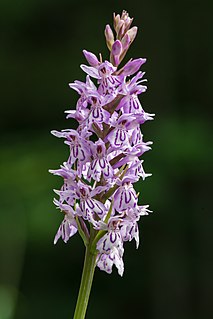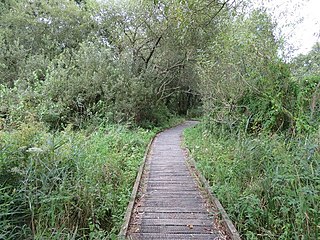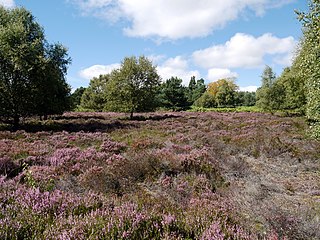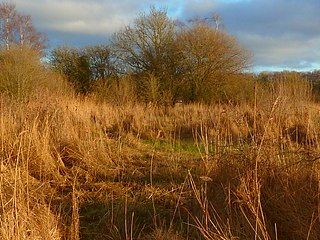This article needs additional citations for verification .(August 2011) |

Ireland is in the Atlantic European Province of the Circumboreal Region, a floristic region within the Holarctic.
This article needs additional citations for verification .(August 2011) |

Ireland is in the Atlantic European Province of the Circumboreal Region, a floristic region within the Holarctic.
Ireland has a small flora for a European country because of its small size, lack of geological and ecological variation and its Pleistocene history. [1] There are 3,815 species of plant listed for Ireland: [2]
An additional 2,512 species of fungus occur in Ireland.

Ice-sheets covered most of Ireland until 13,000 years ago when the Holocene began. The majority of Ireland's flora and fauna has only returned as the ice sheets retreated and sea level rose accompanied by post-glacial rebound when 10,000 years ago the climate began to warm. At this time there was a land bridge connecting Wales and the east coast of Ireland since sea levels were over 100 metres lower than they are today (water being frozen into the ice caps covering northern Asia and North America). Plants and animals were able to cross this land-bridge until about 7,500 years ago, when it was finally covered by the rising sea level as warming continued.
Mesolithic hunters entered Ireland around 8000 BC beginning human occupation and from the Neolithic landscape was progressively altered by agriculture, especially in the 19th and 20th centuries. Aside from the habitat alteration new species were introduced deliberately or accidentally. The archaeologist Emmet Byrnes and botanist Declan Little, Woodlands of Ireland give a history of woodlands in Ireland. [3]

There are two major habitats, making up most of the land area:
Grassland includes Lowland meadow and pasture with grasses such as sweet vernal grass, perennial ryegrass, meadow foxtail, false oat-grass, crested dog's-tail, Festuca rubra , red fescue, downy oat-grass, Yorkshire fog, timothy grass and yellow oat-grass.
Lowland meadow and pasture flowers include meadow thistle, creeping thistle, spear thistle, pignut, lesser knapweed, meadow thistle, smooth hawksbeard, eyebright, ragged robin, red bartsia, yellow rattle, marsh lousewort, cowslip, catsear, autumn hawkbit, meadow buttercup, bulbous buttercup and dandelion

Upland pasture (mostly semi-natural, that is maintained by particular farming practices such as grazing and mowing). Typical species are: moor matgrass, wavy hair-grass, species of Agrostis , sheep's fescue, green-ribbed sedge, cross-leaved heath, bell heather, bilberry, black crowberry, deergrass and bog asphodel.

Ireland possesses almost 200,000 hectares (490,000 acres) of actively growing bogs and fens. This compares with 126,000 ha (310,000 acres) in the United Kingdom, 500 ha (1,200 acres) each in Switzerland and Germany and total loss in the Netherlands and Poland. In Ireland in 1998 there were 23,628 ha (58,390 acres) of raised bog at 164 sites (8% of original area), 143,248 ha (353,970 acres) of blanket bog at 233 sites (18% of original area) and 54,026 ha (133,500 acres) hectares of fen at 221 sites (58% of original area). These 200,000 hectares of actively growing raised and blanket bogs and fens are of European conservation importance.
In Ireland two factors led to the formation of such extensive peatlands. High rainfall- there are 175 rain-days each year in the west, southwest and northwest of Ireland and poor drainage The bogs formed at the end of the last ice age, about 10,000 years ago in the central lowlands of Ireland in basins of calcareous boulder clay. These became lakes overgrown with fen vegetation and infilled with fen peat which cut off the surface plants from mineral-rich water below. Nutrient-demanding fen plants were then replaced by bog mosses and plants which could survive on low levels of nutrients. The fen peat below prevented the rainwater draining away and the sponge-like bog moss and plants soaked it up. [4]
The vascular plants characteristic of raised bogs (an example is the Bog of Allen) include: common heather, cross-leaved heath, bell heather, bogbean, hare's-tail cottongrass, common cottongrass, bog-rosemary, common cranberry, bog asphodel, bog myrtle, Pedicularis sylvatica , round-leaved sundew, oblong-leaved sundew, great sundew, royal fern, species of Utricularia , Juncus squarrosus , common tormentil, black bogrush, bog orchid, Slender Scottish Eyebright ( Euphrasia scottica ), [5] heath bedstraw, green-ribbed sedge, little green sedge, black crowberry, moor matgrass, soft rush, northern firmoss and wolf's-foot clubmoss.
Cut-out raised bogs are colonised by a wet woodland of birch and alder trees. Characteristic species are downy birch, black alder, grey willow, crack willow, broad buckler fern, narrow buckler fern and remote sedge.

Open water habitats include rivers, canals, lakes, reservoirs, ponds and, uniquely, turloughs. Common species of wet places include common reed, marsh willowherb, common marsh bedstraw, water avens, angelica, brooklime, marsh pennywort, water plantain, marsh cinquefoil, marsh marigold, watermint, yellow water lily, bulrush and the invasive species Canadian pondweed.
A much smaller fraction is occupied by coastal habitats (muddy shores, rocky shores, sandy shores, shingle beaches, brackish water bodies, saltmarsh, maritime flushes and streams, sea cliffs and sand dunes and machair). [6] [7]

Significant or characteristic species of sand dunes and dune slacks are: Ammophila arenaria , seaside sandplant, sea milkwort, pyramidal orchid, sea holly, sea lyme grass, heartsease, houndstongue, common centaury, fairy flax, seashore false bindweed, dovesfoot cranesbill, bee orchid and stone bramble. Saltmarsh species include Salicornia europaea , sea purslane, sea arrowgrass, greater sea-spurry and common scurvygrass.
Karst, inland cliffs and scarps

Over 70% of Ireland's 900 native species occur in The Burren which is less than 0.5% of the area of Ireland. [8] The Burren contains twelve Annex 1 habitats listed in the EU Habitats Directive. A 2001 survey found 28 different species per square meter (averaged over 1,100 vegetation samples) in upland grasslands, with up to 45 species per square metre in some samples. [9] 22 of Ireland's 27 native orchid species are found in the region. Such high diversity has several explanations. Firstly, several hundred square kilometers of species-rich unimproved limestone grasslands and upland pastures grazed mainly in winter, a practice which removes potentially dominant grass and weed species. Secondly, there is a mixture of Arctic–alpine and Mediterranean species, and calcicole and calcifuge species. The area is dominated by bare rock and rendzina soils.

Woodland plants include wood sorrel, blackthorn, bird's nest orchid, wood anemone, bluebell, wood avens, bugle, ramsons, self-heal, dog violet, honeysuckle, holly, lords and ladies, herb robert and woody nightshade. Woods dominated by oak and birch, with lesser amounts of rowan, holly, hazel, yew and aspen are called western oakwoods and occur principally in the uplands of Ireland, Scotland and Wales. [2] They are temperate rainforests.

Quarries, gravel and sand pits, roads and railways, field boundaries, walls, waste ground and rubbish tips contain such plant species as common ragwort, pineapple weed, hairy bindweed, creeping buttercup, common daisy, catsear, coltsfoot, fat hen, nettle, redshank, germander speedwell, ivy-leaved toadflax, rosebay willowherb, great willowherb and wall pennywort.
Cultivated ground (arable and horticultural land)
Julie A. Fossitt gives a habitat classification. [10]
Threats to the flora include agriculture, drainage, housing developments, golf courses, mowing of roadside verges and introduced species. Conservation agencies include the National Parks and Wildlife Service (Ireland), the Northern Ireland Environment Agency, the Environmental Protection Agency and the Royal Society for the Protection of Birds. There is a Threatened Species Programme at the National Botanic Gardens. There was also a range of Non-Governmental Organisations in Ireland dedicated to preserving plant habitats such as the Irish Peatland Conservation Council, the Irish Wildlife Trust and the Native Woodland Trust.
Major herbaria are conserved at the National Botanic Gardens and the Ulster Museum.
History of botany in Ireland

Dactylorhiza fuchsii, the common spotted orchid, is a species of flowering plant in the orchid family Orchidaceae.

Galway Bay is a bay on the west coast of Ireland, between County Galway in the province of Connacht to the north and the Burren in County Clare in the province of Munster to the south. Galway city is located on the northeast side of the bay. The bay is about 50 kilometres (30 mi) long and from 10 kilometres (6 mi) to 30 kilometres (20 mi) in breadth. The Aran Islands are to the west across the entrance and there are numerous small islands within the bay. To the west of Galway, the rocks are granite but to the south they are limestone.
Yanal Bog is a 1.6 hectare biological Site of Special Scientific Interest on the southern edge of the North Somerset Levels, just north of the village of Sandford, North Somerset. It was notified as an SSSI in 1988.

Cowles Bog is a 4,000-year-old wetland complex in Indiana Dunes National Park, near Chesterton, Indiana. It is named for Henry Chandler Cowles who did his pioneering work in ecology and ecological succession here. His work brought international attention to the area which led to efforts to preserve the Indiana Dunes. It was designated a National Natural Landmark in 1965. It contains bog, fen, marsh, wet meadow, swamp, and pond habitats.

The flora of Scotland is an assemblage of native plant species including over 1,600 vascular plants, more than 1,500 lichens and nearly 1,000 bryophytes. The total number of vascular species is low by world standards but lichens and bryophytes are abundant and the latter form a population of global importance. Various populations of rare fern exist, although the impact of 19th-century collectors threatened the existence of several species. The flora is generally typical of the north-west European part of the Palearctic realm and prominent features of the Scottish flora include boreal Caledonian forest, heather moorland and coastal machair. In addition to the native varieties of vascular plants there are numerous non-native introductions, now believed to make up some 43% of the species in the country.

Thirty-seven species of mammals have been identified at Indiana Dunes National Park. Four other species are thought to inhabit the park, but have not been documented: the northern long-eared myotis, the Indiana bat, the hoary bat, and the southern bog lemming

Purple moor grass and rush pastures is a type of Biodiversity Action Plan habitat in the UK. It occurs on poorly drained neutral and acidic soils of the lowlands and upland fringe. It is found in the South West of England, especially in Devon.

The native flora of Saskatchewan includes vascular plants, plus additional species of other plants and plant-like organisms such as algae, lichens and other fungi, and mosses. Non-native species of plants are recorded as established outside of cultivation in Saskatchewan, of these some non-native species remain beneficial for gardening, and agriculture, where others have become invasive, noxious weeds. Saskatchewan is committed to protecting species at risk in Canada. The growing season has been studied and classified into plant hardiness zones depending on length of growing season and climatic conditions. Biogeographic factors have also been divided into vegetative zones, floristic kingdoms, hardiness zones and ecoregions across Saskatchewan, and natural vegetation varies depending on elevation, moisture, soil type landforms, and weather. The study of ethnobotany uncovers the interrelation between humans and plants and the various ways people have used plants for economic reasons, food, medicine and technological developments. The Government of Saskatchewan has declared 3 indigenous plants as provincial symbols.

Winnall Moors is a 64-hectare (160-acre) nature reserve in Winchester in Hampshire. It is managed by the Hampshire and Isle of Wight Wildlife Trust.
Trodds Copse is a 25.23 hectare biological Site of Special Scientific Interest (SSSI), in central Hampshire, notified in 1989. It comprises ancient semi-natural woodland, unimproved meadows and flushes.

Cefn Blaenau is a 23-hectare Site of Special Scientific Interest in a small upland valley in Carmarthen and Dinefwr, Wales. It was designated an SSSI in 1989, primarily for its flush and spring vegetation as well as the diverse mosaic of unimproved pasture, ‘ffridd’ land, marshy grassland, wet heath, acid grassland, broadleaved woodland, streams, and small rock outcrops. These habitats, which are well represented at this site, have been greatly reduced in north Carmarthenshire due to land improvement, agricultural intensification, and afforestation. Only about 140 hectares of flush and spring vegetation remain in the county.
Monawilkin is a townland in the West Fermanagh Scarplands in the Civil Parish of Inishmacsaint, Barony of Magheraboy, Northern Ireland. The townland has an area of 85.1947 hectares and has previously been referred to as Meenwilkin (1817) and Munadh Wilkin. Monawilkin is the best example of unimproved calcareous grassland in Northern Ireland. This differs from other Sesleria-dominated grasslands in the UK in that it also includes species such as Euphrasia salisburgensis (eyebright). Monawilikin is also an important orchid site, contains the best inland site for moths and butterflies in Northern Ireland, and is the only Northern Irish site for Cupido minimus, the small blue butterfly. Consequently, this area was designated as a special area of conservation (SAC) and area of special scientific interest (ASSI). The Monawilkin SAC land cover comprises 3% water bodies, 5% bogs, marshes, and fringe water vegetation, 13% heath and scrub, 50% dry grassland, 14% humid grassland, and 15% broad-leaved woodland.
Abrod is a national nature reserve in the Slovak municipality of Veľké Leváre in the Malacky District. The nature reserve covers an area of 92 ha of the Borská lowland area. It has a protection level of 4 under the Slovak nature protection system. The nature reserve is part of the Site of Community Importance with the same name which measures 162 ha. Since 1988 it is also a part of the Záhorie Protected Landscape Area.

Bewick and Beanley Moors is the name given to a Site of Special Scientific Interest (SSSI) in north Northumberland, in the north-east of England. The moors are asserted to be of national importance by Natural England for the extent, quality and diversity of upland types including heaths, fens, wet grassland, flushes, mires and blanket bogs, together creating an extensive mosaic habitat supporting an exceptional community of amphibians. The moors are important, too, for their relict juniper woodland and scrub.

Farnham Mires is a Site of Special Scientific Interest, or SSSI, to the east of the village of Farnham, North Yorkshire, England. It consists of a spring-fed marshy fen or mire with reeds and sedge, and drier calcareous grassland containing a diverse range of flora. It has a history of poaching and fox hunting, but since the late 19th century, the attention of botanists has been drawn to its large variety of flowering plants. It has received some consideration on this account since 1944, and from 1954 it was designated SSSI status. This site has no facilities, and is not open to the public.

Cow Myers is a Site of Special Scientific Interest (SSSI) located in the Nidderdale Area of Outstanding Natural Beauty (AONB), near Ripon, North Yorkshire, England. The site was designated in 1984 for its fen and alder carr habitat, which supports a diversity of wetland plant life. Of particular interest are the bird's eye primrose which is scarce in Yorkshire, and early marsh orchid. There is no public access to this site, no vehicular access, and no public facilities.

Mar Field Fen is a Site of Special Scientific Interest, or SSSI, north of Masham, North Yorkshire, England, in a rural area known as Marfield. It is situated on land containing woodland carr, fen, spring-fed marshy grassland and drier calcareous grassland, between the River Ure to the east and Marfield Wetland nature reserve to the west. As "one of the best examples of fen habitat in the Vale of York," it is a protected habitat for a variety of plants, including the common butterwort, a carnivorous plant. There is no public access to this site.

Krustkalni Nature Reserve is a nature reserve located in eastern Latvia that was founded in 1977. Its area is 2978 hectares. Since 2004, this institution has been part of Natura 2000, the European network of protected areas. The reserve is managed by the regional administration Latgale.
| Wikimedia Commons has media related to Flora of Ireland . |